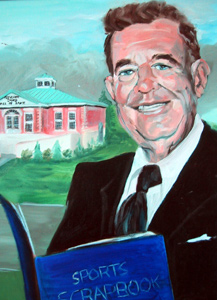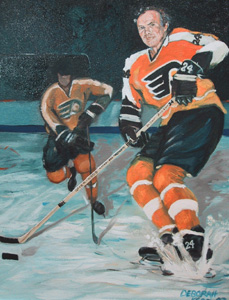1993
Agnes McArthur | Jim Hill | Archibald MacDonald | Ralph MacSweyn | Carman Marshall
Condie participated in such varied sports as basketball and the needle race
while attending WHS, and excelled at all her athletic endeavors. While girls
and women of later generations would be scorned for their involvement in
athletics, women’s sports were surprisingly poplar in the early 20th century
For example. many people believe women’s ice hockey to be a fairly recent innovation. In actual fact, women have been playing hockey for almost as long as the sport has existed. Women’s hockey was a varsity sport at the time Condie attended university, and she played left wing for the Queen’s team. Condie also played field hockey and basketball while at Queen’s and she helped the Kingston school win championships in both sports. Queen’s won the field hockey crown in both 1917-18 and in 1918-19 and the basketball title in 1919-20. She was also captain and president of the field hockey team in 1919-20. Condie graduated from Queen’s in 1920 (along with fellow Williamstown H.S. graduates Beryl Mowat, Edith Sangster and Margaret Cattanach and the school yearbook from that year contains the following comments about Bainsville’s great all-round athlete: “Agnes is essentially an outdoor girl, interested in sports. She played on the Queen’s Junior Basketball team and on the year championships team in 1920, and was the strong left wing on the ice-hockey team. But especially in ground (field) hockey did Agnes excel… Not only was Agnes known in the field of sport, but also as a member of Y.W. (Young Women’s) executives. As treasurer and convener of extension work, Agnes ably displayed her Scotch trustworthiness. Also her naturalness and straightforwardness won her many firm friends…” |
Jim’s interest in sports was lifelong and varied. During his youth in
Montreal he participated in activities as disparate as football,
softball, hockey, rowing, and curling. But Jim was not just a player of
sports – he was an organizer and above all, a volunteer. During his
Quebec days he held numerous executive positions in different sports
associations, including the presidency of the Quebec Rugby Football
Union, which he continued to hold even after moving to Williamstown in
1962.
In fact, shortly after his permanent arrival in Glengarry (he and his wife, Laura, and family of four had spent summers in the country since 1952). Jim became involved in the foundation of the Lancaster Curling Club. Here he devoted many house, not only curling, but organizing the club’s annual fish-fry fundraising event, and cooking at it, too. Perhaps Jim’s main contribution to the Sports Hall of Fame lies in the work he did in keeping alive the history of the Hall. Along with Hall of Famer, the late Angus H. McDonell, Jim kept meticulous records, in triplicate, of everything pertaining to the local sports shrine. Recorded in his scrapbooks are press clippings, ticket stubs, and plans for the new building, which opened in Maxville in 1990. In fact, so thorough was Jim in recording the Hall’s history, that, less than a week before his death, while the ambulance was waiting to take him to the hospital, he insisted upon checking to make sure the latest clipping had been pasted in the scrapbook! In 1988 Jim and Laura set about to ensure that local interest in the Hall of Fame would continue into future generations. They decided to invite 15 young athletes from all parts of Glengarry to the annual induction dinner, as Laura’s guests. Jim was responsible for choosing the youths from south Glengarry, and acted as emcee for the junior athletes at the dinner, as well. The Hills’ theory seems to have worked. A thank you note from one of the young people says it all. “Thanks a lot for thinking of me. You will be sure to see me there (at the dinner) in the following years.” Jim Hill – athlete, enthusiast, historian and philanthropist – an exemplary volunteer and very worthy inductee of the Glengarry Sports Hall of Fame. |
From caddying he moved to playing, and captured several club championships between the years of 1936 and 1954. During World War II, Archie enlisted in the Air Force and served his country from 1941 to 1945.
Throughout his hockey career, which was extensive, Archie’s play was of high calibre. During the 1946-47 season, he was a member of the Cornwall Falcons team which went to the Allan Cup playdowns. In the decade between 1960 and 1970, Archie remained with the sport of hockey, acting as trainer for the Knoxville Knights and the Tulsa Oilers. Realizing the need for golfers to practice, Archie set up his driving range in 1955 and remained involved for 30 years, before selling the business in 1985. |
Born in 1942, the third child of Ella and Donald MacSweyn, Ralph obtained
his first pair of skates at the age of five. He learned to skate on the river
that ran through the family farm, and on the outdoor rink that his grandfather,
Dan (Mulligan) MacDonell was instrumental in making and maintaining each year.
Playing with boys much older than himself, Ralph was relegated to the position of goalie. He excelled in nets and remained a goaltender until the age of 17, when he started his career as a defenceman. Perhaps it was his early netminding that made Richmond Robins coach, Eddie Busch comment, “Having MacSweyn on the ice is like having a second goaltender, he blocks so many shots.” As a defenceman Ralph played for a variety of teams: Eastview in the Ottawa Jr. League, Lancaster Dodgers in the Ottawa Valley Senior League, and Johnston Jets in the semi-professional Eastern Hockey League. In the late 70’s Ralph had the distinction of being selected to the Alltime Jets team as a first team defenceman. During 1967-68, the Philadelphia Flyers offered Ralph a contract and assigned him to their top farm team in Quebec – the Aces- where he remained for four seasons. Called up by the Flyers on numerous occasions during these years, Ralph was named second star in games against the Chicago Blackhawks and the Toronto Make Leafs. In 1972-73, Ralph was selected first in the World Hockey League draft by the Los Angeles Sharks where he played for two years. Ralph ended his professional hockey career playing for the Vancouver Blazers, where he was clearly a crowd-pleaser. Known as ‘Big Mac’ he won the ‘Fans’ Favorite Player’ award for his hard-hitting defensive play. Today Ralph farms on the Dunvegan Road. He is still involved in hockey – as a coach for his daughter’s team in the RCAFA Girls’ Hockey Association in Cornwall. For his excellence as an athlete, bringing honors to his family and his county, Ralph will become a member of the Glengarry Sports Hall of Fame. |
Having been recruited in 1949 by the Hull Volants, who played in the Eastern Ontario Senior League, Carman accompanied the team on a successful European tour to Scotland, England, Holland, Belgium, Sweden, France, and Switzerland. During his second year with the Hull Volants, he was selected for the second all-star team.
With the Cornwall Colts in 1951-52, his team won the league championship, only to be eliminated by Matane in the first round of the Allan Cup playdowns. The next two years were spent with the Colts in the OHA Senior League competing against the Kingston Canadians, Belleville McPharlands, Whitby, Dunlops, and Ottawa-Hull Junior Canadians. Coach Frank Mario described Carman as a dedicated hard-working team man, a solid defenceman who could move the puck very well, particularly out of his own end. After playing the 1955-56 season with the Cornwall Chevies, Carman gave up competitive hockey. However he stayed with the game by playing with Cornwall old-timer teams. After forty years of service with CN and VIA, Carman retired January 31, 1990. A widower, he resides in Cornwall, and has two sons, David and Paul. It is fitting that his hockey abilities, and his successes, be recognized. |





